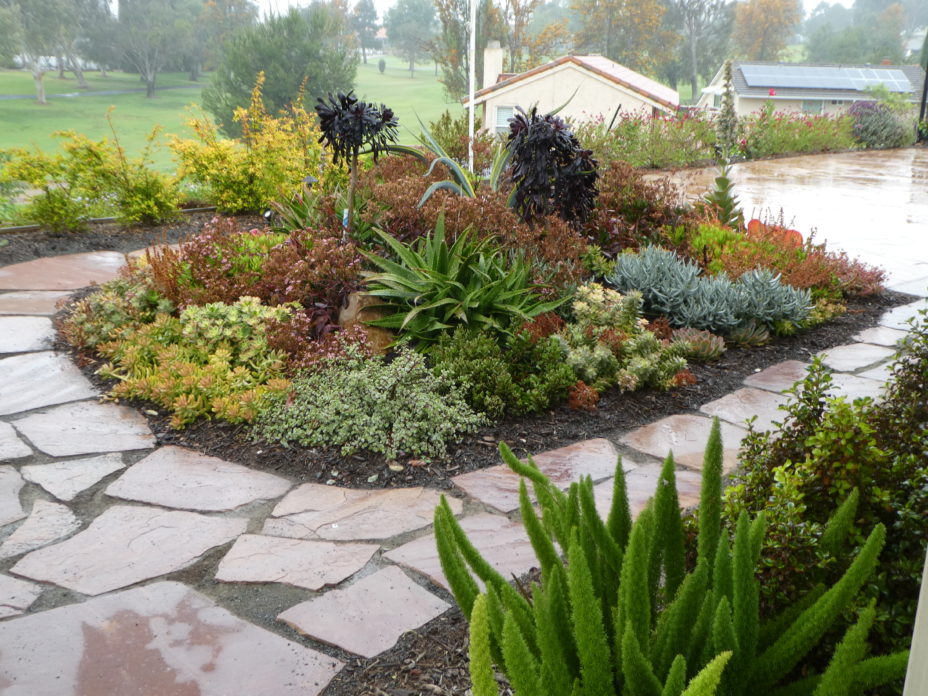Companion Plants for Succulents
In March, the Mission Hills Garden Club learned that many plants thrive amidst succulents. Linda Bresler, a certified landscape designer, is truly an artist using living plants as her canvas. In her talk, she gave us a host of types of plants with which to paint our yards.
We learned that from early childhood, Bresler loved plants and dirt. Nevertheless, Bresler began with a career teaching English and Reading Improvement after attending the University of Pennsylvania for both her B.A. and master’s degrees. However, she has been a landscape designer for over thirty years. After living in Poway for twenty years, she and her husband moved to Escondido where she tends her garden of several acres. She says, “From personal experience, I choose the hardiest, most waterwise, low-maintenance plants that look beautiful year-round for my landscape designs.”
Bresler’s teaching talents came through as she showed slides of gardens she has designed and plants we might like to use. She also gave us a list of plants she likes for their ease of tending and their attractiveness throughout most of the year.
Bresler became interested in landscape as art partly because she hated flowers to die after they were
picked. As a result, her designs focus on the landscape itself, whereas the average landscape architect focuses more on the hardscape. This means she concentrates on the actual plants as seen from various locations. Will they be framed by a window? By a doorway? By the entrance through a gate? What will one see if one is in a sitting area? Bresler takes more than the view into consideration. She is aware of textures produced by leaves, branches, and flowers as well as their colors, shapes, sizes, and physical requirements.
Showing us several examples of how she makes her choices, we saw that her photographs portray not just the frame of the landscape, but additionally they reveal the colors, textures, shapes, and sizes that influence the result. She pays attention to what blooms when. Since she is frugal with water and reluctant to fertilize, she searches for plants that have color most of the year, and she makes certain that other plants will bloom in the flowerless interim or have interesting leaves when blooms are spent.
We received a double-sided paper listing colorful drought-tolerant plants of varying shapes and sizes so that we could plan our own gardens. I must say, I lack her vision, talent, and knowledge. Furthermore, I failed to follow one important piece of Bresler’s advice: Google the plants on her list to remember how they look and what they need. Do have a plan for their location.
Since I am impatient and impulsive, armed with my list, I set out to find plants with long lasting blooms. I found one beautiful yellow plant and some blue fescue. I am happy with where the yellow plant is, but I’d like another to go on my balcony because it “makes a statement,” which my garden has yet to do. I don’t remember what it is called. My garden looks as if someone chose a particular location for ease of digging. Guess what? That is how my garden grows.
Bresler does not advocate buying fancy topsoil. Add sand to your soil to help drainage; perlite to hold water. In addition, mulch adds nutrients to the plants as it decomposes. Mulches are a good for maintaining soil temperature and moisture. For steep hillsides, Bresler likes “Gorilla Hair” which helps to hold the soil and plants.
Bresler showed us several before and after photos. It is obvious that each garden was carefully thought out. We saw slides of homes surrounded by dirt or uninteresting bushes and weeds. Then we saw photos of the gardens seen from various angles including closeups of beautiful plants and flowers. One of her favorites is the miniature ‘Clivia” which has either orange or yellow long-lasting blooms and glossy green leaves that remain healthy with little attention.
Peaches and Cream Grevillea is another favorite which blooms nearly 365 days a year with neither fertilizer nor phosphorus. “Hummers love it,” she says. A few other plants that have nearly 365 days’ bloom are Grevillea Superb J, Gold Star Yellow Bells shrub, Firecracker or Coral Fountain Plant, and Sierra Starr Fairy Duster. Amistad Sage is another long-blooming plant. You could also look for Sweet Pea Shrub, which thrives in some shade. Blue Bells Emu Bush is a low-growing bush with year-round flowers. The Elijah blue fescue is beautiful planted under roses and is invasive, nor is Heavenly Bamboo as it is not bamboo at all and is beautiful and delicate looking all year. You can also find a miniature Jacaranda, Bonsai Blue Dwarf, which tops out between 10 to 12 feet.
It was refreshing to see what Bresler can do to beautify one’s surroundings with judicious and carefully thought-out designs. Hiring Bresler would be far easier than memorizing all these plants, figuring out where to plant them, and then getting soil ready to house them. An added advantage is that Bresler can find plants that will be beautiful yet thrive in our heavy, clay-like soil. You can find more about her on her website: www.livingdesignsbylinda.
Don’t forget the garden walk, Home Grown, on Saturday, May 7, the day before Mother’s Day.
Tickets have sold out, but there may be a few openings at Mission Hills Nursery, 1525 Fort
Stockton. If there are tickets left, they may be available after 11:30 a.m. that day. If you join the
Mission Hills Garden Club, you will receive advance notice on club activities and programs.
June will have a Botanical Garden Cocktail Workshop.

Category: Events, Gardening, Life Style, Local News, Nonprofit







